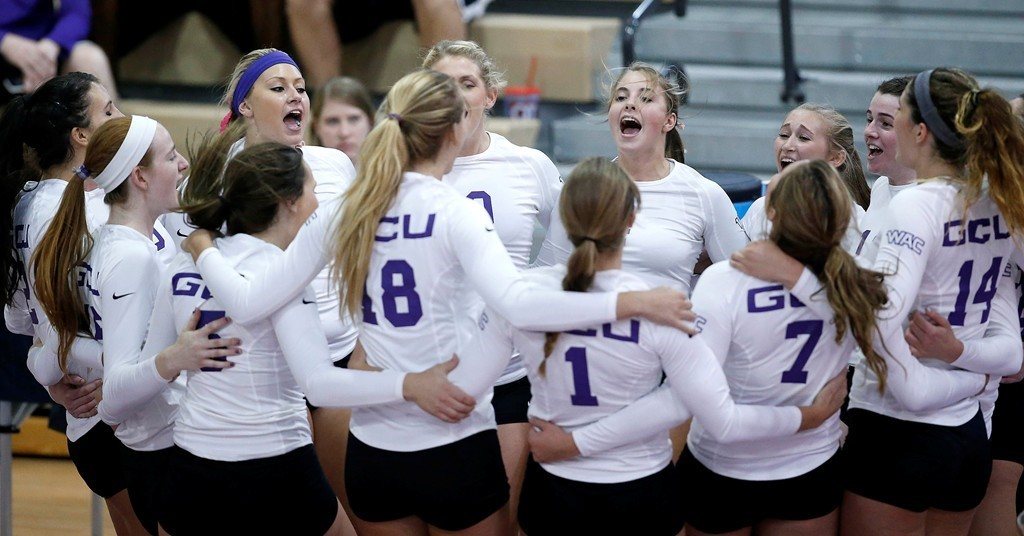After completing four years of competition at the Division 1 level on a probationary status, Grand Canyon University has officially been given Division 1 status and will be eligible for postseason play for the first time across all sports. This will impact all three Antelope volleyball programs moving forward, but especially on the women’s side. Nearly all of the school’s varsity sports will compete in the Western Athletic Conference (WAC), allowing them the ability to participate in postseason conference tournaments with the opportunity to earn a spot competing in the NCAA tournament.
Grand Canyon women’s indoor volleyball team finished the 2016 regular season at 6-21 and graduated 5 seniors, but the ‘Lopes do return their three top scorers from last season. Rendahl Powers led the team with 231.5 total points on the season, Jordyn Sanchez scored 209.5, and Katrice Pond chipped in 187. The roster has been also bolstered by the addition of freshmen Teagan DeFalco and Claire Kovensky. In addition, the women’s team added Tressa Schuler and Kendall Gray as transfers this offseason and they look to make an immediate impact. UT Rio Grande Valley won the 2016 WAC Tournament and made the NCAA Championships for the first time in program history.
The beach volleyball team is coming off back to back strong seasons, finishing 18-8 in 2016 and 17-8 in 2017. In 2017, the beach volleyball program also unveiled a brand new on campus stadium. The 2018 squad will be playing the year in memory of assistant coach Joseph Rohr who passed away in July. He was the husband of current head coach Kristen Rohr.
On the men’s side, the 2017 squad had an historic run for the program that saw them host a playoff game for the first time and reach the MIVA championship match for the first time, where they lost to eventual NCAA champion Ohio State. The men’s team was eligible to play in the playoffs in 2017 because they were playing under Division 2 status. The 2018 squad will return two of their top scorers in Shalev Saada and Ashton King, as well as welcoming back redshirt senior setter Puna Kaniho. The team will compete in the MPSF conference for the 2018 season as the sport of men’s volleyball continues to grow.

Brandon
Nice little article about GCU, but I am wondering how you have come to the conclusion that men’s division 1 MCAA volleyball is growing.
There are less than half the men’s VB scholarships available today then when MVB scholarships first became offered 40 years ago, in 1977. Today, there are over 10 woman’s VB scholarships available for every single men’s division 1 volleyball scholarship available.
I am not sure what type of math you are using to determine this increase in men’s division 1 volleyball, but the above facts would indicate that your conclusion is entirely incorrect.
Even men’s World competition and Olympic volleyball has been on life support for the last 20 years. During the last Olympics, there were seven viewers for women’s volleyball events for every one viewer of men’s volleyball for televised events.
What is really needed in men’s volleyball is honest commentary, by supposed volleyball experts like you, on the truly deplorable state of the USA men’s sport, and the lack of focus by USA Volleyball on trying to reverse this death spiral.
There are only so many second-tier colleges, like GCU, who will fill the gaps after other established first-tier colleges terminate their men’s NCAA volleyball programs, until NCAA men’s volleyball is eliminated completely by the NCAA as a men’s division 1 sport.
For the sake of men’s NCAA division 1 volleyball, I hope you are able to shed a more accurate and honest light on the true state of men’s NCAA volleyball.
Buster Boy – he doesn’t say that men’s Division I volleyball is growing. He says that men’s volleyball is growing. Here’s the math:
https://volleymob.com/mens-volleyball-sees-86-ncaa-participation-increase-over-15-years/
https://volleymob.com/boys-volleyball-remains-among-fastest-growing-high-school-sports/
Furthermore, I noticed a typographical error in my original response. The ratio of women’s volleyball scholarships to men’s volleyball scholarships, at all divisions, is greater than 100 to 1. I had originally written 10 to 1